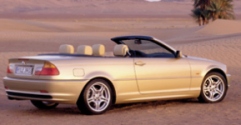
This Week:
© 1998
- 2000 Copyright &
Disclaimer
Automotive Intelligence,
www.autointell.com
All Rights Reserved .
For questions please contact
editor@autointell.com

News of May 16, 2000
| BMW Group improving worldwide – the
best four months of all time . |
|
| Munich - The BMW Group is
continuing along the steady route to growth: the number of BMW Rover, Land Rover, MG and
Mini brand vehicles delivered - total: 423,700 units - was the highest ever in the first
four months of the year.
|
BMW 3 Series Convertible Photo: BMW |
| This includes the best figures for both the BMW
Group and the BMW brand. (Note: After the handover of the Rover brand, the sales of Rover
vehicles will be included for the last time in May.) The most recent growth marks a nine
percent increase over the same period last year. This success is primarily driven by the
successes enjoyed by the BMW models. Since the beginning of the year, new BMW records are
being set every month. 269,600 BMW cars were delivered to customers world-wide up to the
end of April 2000, which is 20,600 units, or 8%, more than in the first four months of the
previous year. Professor Joachim Milberg, Chairman of the Board of BMW AG, commented:
"This development means that we can forecast a level of sales of over 800,000 BMW
cars for the whole of 2000 - assuming that there are no major distortions of any of the
important individual markets". One particularly interesting feature is the increase in the value of the diesel business: at 60,4000 units, it is around 38% above the interim value last year - a clear indication of the general awareness of BMW's expertise in the diesel sector. The generally positive situation is the result of the marketing success of the entire model range. In detail: The 3 series is continuing to develop very successfully; the new coupé and touring models are showing high rates of growth. The newest 3 series model, the convertible, was successfully launched at the beginning of April. Over 200,000 Z3s have now been sold, which means that it is staying steady at last year's level, putting it in second place in the list of "all-time best-selling roadsters". The X5 Sports Activity Vehicle has been launched according to plan and is extremely popular with customers. The 5 series, with the saloon and touring models, is almost at last year's level. Looking at its product cycle to date, it is around 94,000 units (+ 12%) higher than its very successful predecessor. The large saloon series is progressing as expected; the 7 series is also 18,5000 units and seven percent above the corresponding cycle-related volume of its predecessor. Demand for the Z8 is considerably higher than production capacity. The situation in the individual markets: In Germany, the market as a whole is showing a fall in registrations of around 12%. BMW has clearly gone against this trend and has increased its market share from 6.2 to 6.7 percent, even though the market has fallen by three percent. A new historical record of 74,000 orders received in the first quarter means that deliveries in the 2nd quarter are likely to be of a similarly high level. The supply of BMW vehicles to customers in the United Kingdom has been affected by the special conditions prevailing there. Although the figures for the first quarter were 1,400 units above those for the same period in 1999, the massive calls for price reductions pushed down sales in April dramatically, by 1,800 units. Customers clearly held back in the hope that prices would fall. On the other hand, the drop in sales has absolutely nothing to do with the discussions relating to the sale of Rover. In Spain, 8,800 vehicles (29%), Belgium, 7,600 vehicles (22%), France 10,200 vehicles (17%), USA, 58,100 (16%), Canada 3,000 (14%) and Italy, 15,500 vehicles (13%), percentage increases going well into two figures were achieved, with BMW reporting the highest absolute growth in the USA, with + 8,100 units. These are new records for deliveries in the above markets for the period under review. In the 2000 financial year, 88,000 Rover 200 / 25, 400 / 45 and 75 vehicles were sold n all markets. This is around 17% more than in the previous year. This development was due in particular to market and price measures in the UK market, where sales up to April, at 47,600, were 25% higher than in the previous year. In the period up to April 2000, 58,800 Land Rover vehicles were sold, which is around the same level as last year. (May 12, 2000) |
|
[Homepage]
[ News] [ Companies] [ Management] [ Publications] [ Events] [ Careers]
[Services] [Discussion] [ Guestbook] [ Search]
